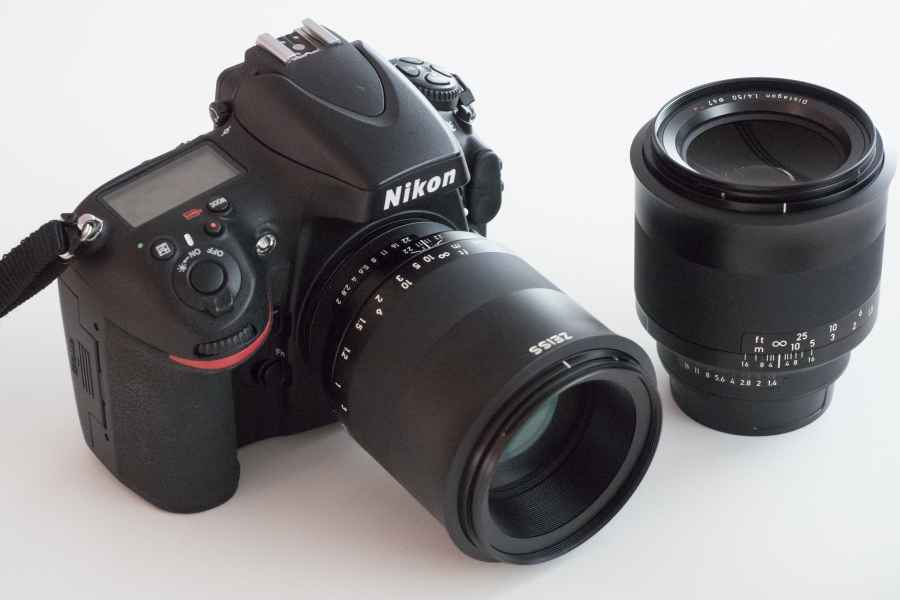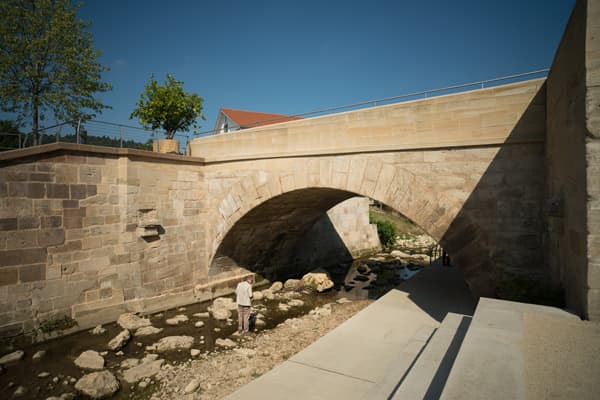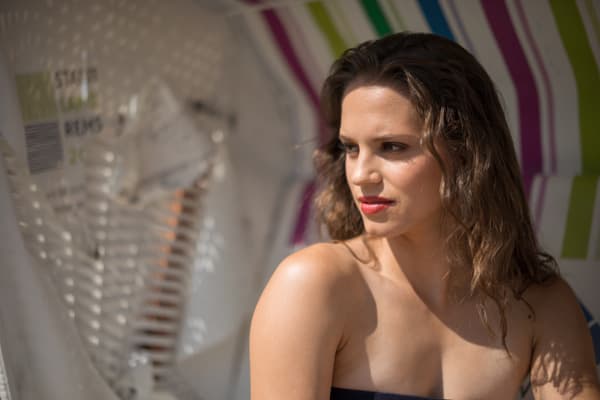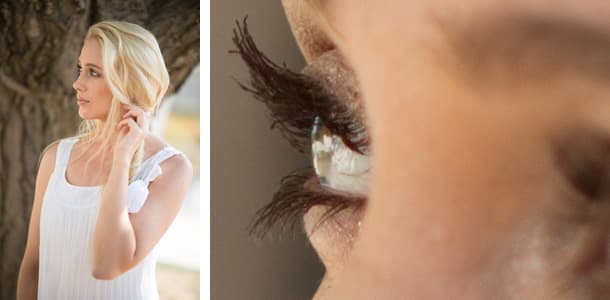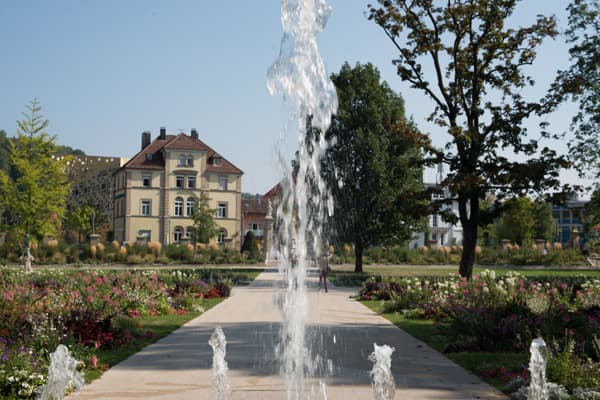Zeiss Milvus Lenses First Look
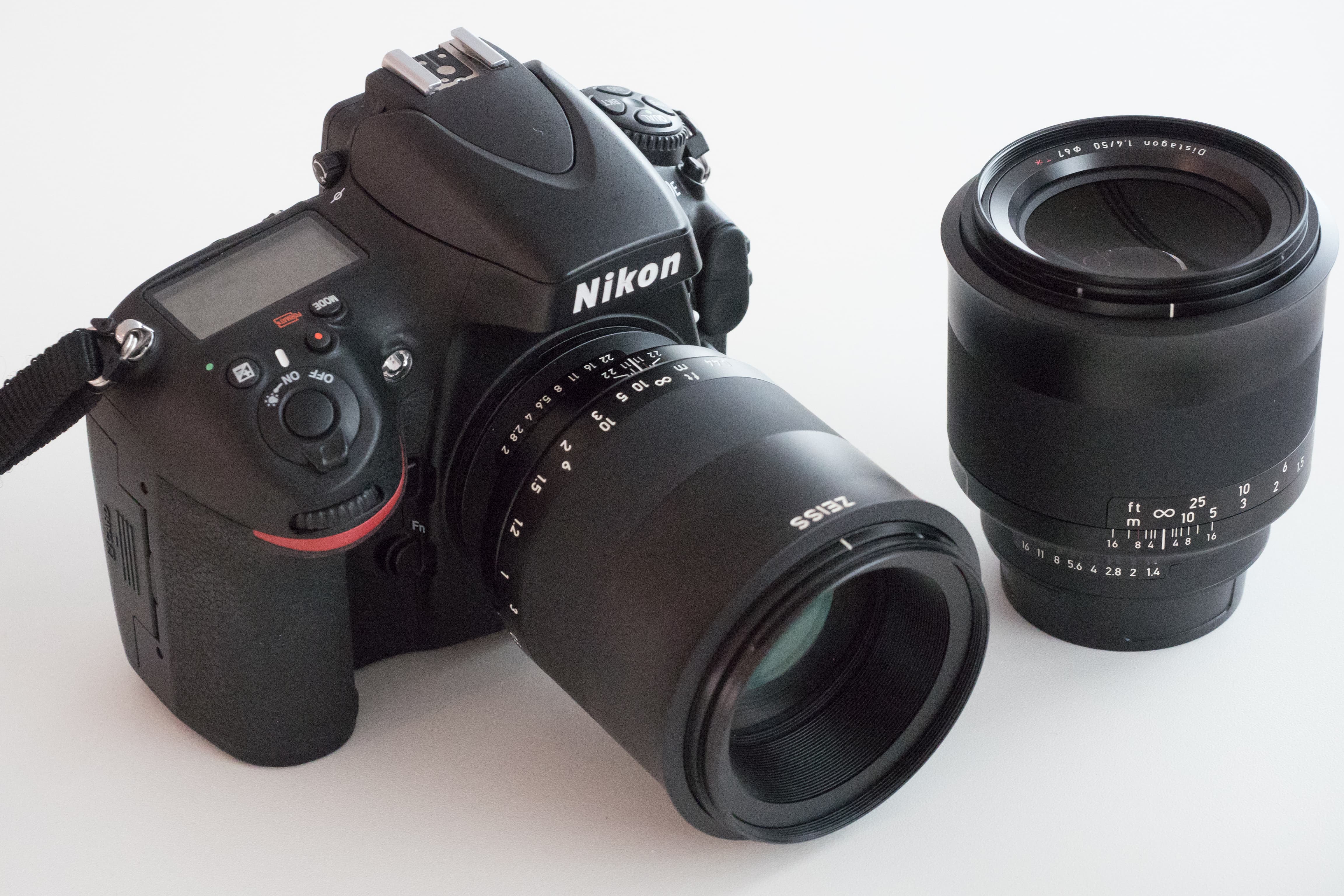
Zeiss Milvus 2/100 (on camera) and Milvus 1.4/50
Zeiss Milvus lenses at a glance:
- Manual focus
- For Canon and Nikon full frame DSLRs
- 21mm f/2.8, 35mm f/2, 50mm f/1.4, 50mm f/2 Macro, 85mm f/1.4, 100mm f/2 Macro
- All-metal barrel construction
- Dust- and splash-proof
- £829 – £1,379 inc VAT
Carl Zeiss AG is one of the grandest old names in all of photography, with a history dating back to 1846. Along with Leica, it’s one of only a handful of names to have survived the shift in dominance from German to Japanese camera makers during the 1950s and 1960s. Based in Oberkochen, Germany, it’s made some iconic lenses in its time, such as the famous Tessar and Sonnar optics. More recently it’s offered premium manual focus lenses for use on Canon and Nikon SLRS, and partnered with Sony in producing Zeiss-badged lenses for its Alpha system cameras.
In the past couple of years, though, it’s shown signs of upping its ambitions. The Otus 55mm f/1.4 and 85mm f/1.4 are designed to offer the ultimate money-no-object optical quality for high resolution full-frame DSLRs, and the Touit line for APS-C compact system cameras saw the firm dipping its toes into the waters of modern autofocus lenses. With the latest Loxia and Batis ranges, Zeiss has started making lenses for the Sony Alpha 7 full frame mirrorless system, and very nice they are too.
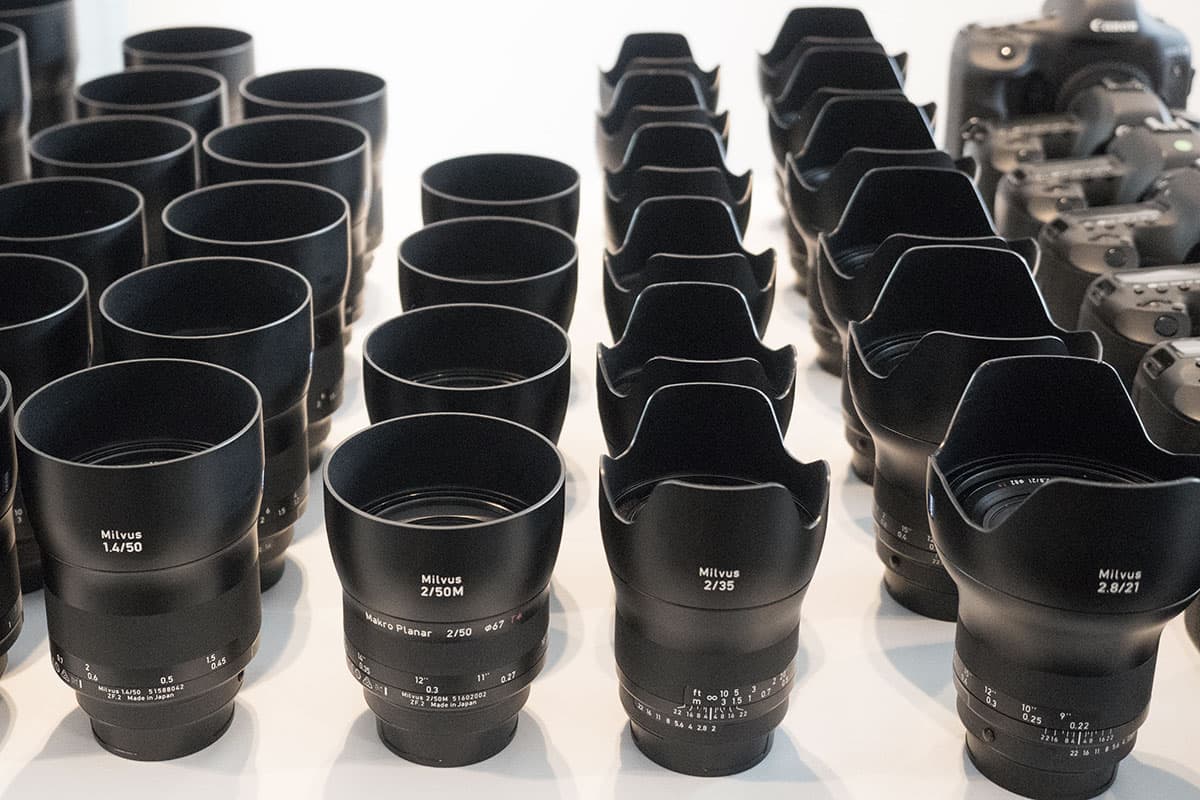
Milvus lenses lined up at Zeiss’s European Press Event
Despite this flurry of activity, Zeiss must have felt under pressure from a newly-resurgent Sigma, whose top-notch Art line of lenses has demonstrated that enthusiast photographers are quite happy to spend in the £500-£1000 bracket in order to get optics that can match the potential of the latest high resolution sensors in the 36MP – 50MP range. With the Sigma 50mm f/1.4 DG HSM Art coming close to matching the Zeiss Otus 55mm f/1.4, but at a quarter of the price and with the added benefit of autofocus, it was perhaps only a matter of time before the company felt the need to offer a response.
The result, announced at a European press event at the company’s headquarters, is a new line of manual lenses designed for high resolution DSLRs. In line with the company’s somewhat whimsical policy of naming its ranges after bird species, it’s been called Milvus. The lenses will go on sale on October 15th 2015, and it’s clear that this new line-up will replace most of the current ‘classic’ ZE and ZF.2 lenses, offering a more modern design and some nice new features.
The Milvus range
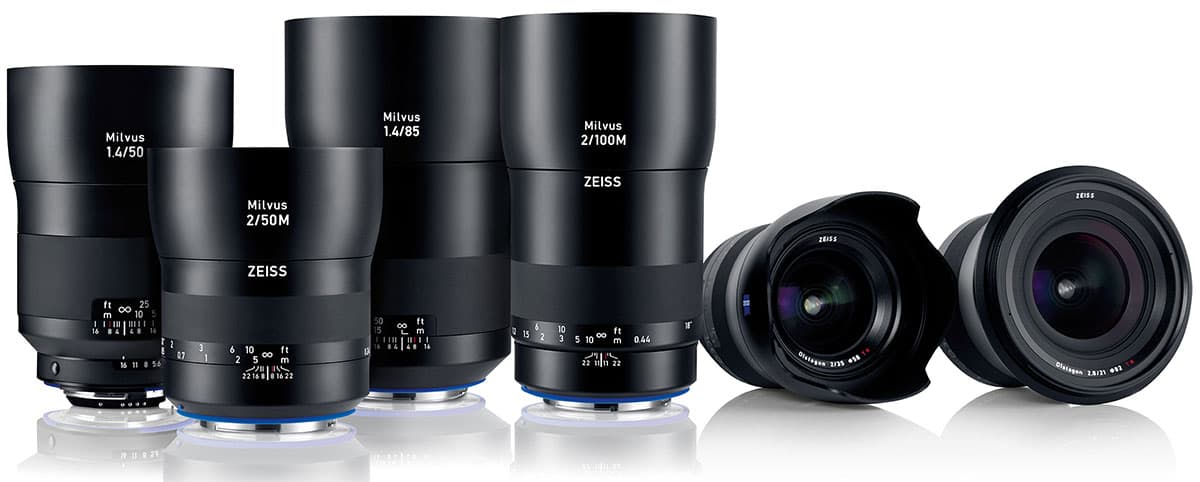
The initial six Zeiss Milvus lenses: 50mm f/1.4, 50mm f/2 Macro, 85mm f/1.8, 100mm f/2 Macro, 35mm f/2, and 21mm f/2.8. Photo: Courtesy of ZEISS
The initial Milvus lineup consists of 21mm f/2.8, 35mm f/2, 50mm f/1.4, 50mm f/2 Macro, 85mm f/1.4 and 100mm f/2 Macro lenses, all wrapped up in Zeiss’s signature matte black and curvaceously modern barrel design. Of these, the 21mm f/2.8, 35mm f/2 and the macro lenses are essentially re-housings of existing optics, although with a number of refinements, including improved coatings to minimise flare. However the 50mm f/1.4 and 85mm f/1.4 are completely new designs, which appear to be heavily influenced by their Otus-series big brothers. Interestingly though, the 85mm uses only spherical lens surfaces, which Zeiss says sacrifices a little in sharpness but gives especially attractive background blur. The older ‘classic’ 50mm f/1.4 and 85mm f/1.4 lenses will remain on sale for users who appreciate their specific optical characteristics.
All of the lenses have a common set of features, including super-smooth manual focus with a large rotation angle and no backlash when you change focus direction. The focus rings have broad rubberised coatings with engraved distance and depth of field scales. The barrels are constructed entirely from metal, with no plastics in sight, and the lenses are dust- and spash-proof, with a blue rubber seal around the mount. They’re even colour-matched for movie work, and the Nikon-mount versions have an aperture ring with clicks at every half stop, and can be switched to clickless operation for video work.

Detail of Zeiss Milvus 1.4/50 for Nikon, showing the blue seal around the lens mount and the de-clickable aperture ring. Photo: Courtesy of ZEISS
Some might be surprised that Zeiss hasn’t progressed to making autofocus SLR lenses. However this is a company that’s spent years arguing that its particular brand of premium optics can only be realised within the tight mechanical constraints of manual focus designs. In particular, there’s no optical compromise from having to use relatively small lens groups for autofocus, and this means that distortion can be minimised and sharpness maximised across the full range of focus distances.
This is still Zeiss of course, and prices aren’t by any means cheap. The Milvus 2.0/35 will cost £829; the Milvus 1.4/50 and Milvus 2/50M, £949; the Milvus 2.8/21 and Milvus 2.0/100M, £1299; and the Milvus 1.4/85, £1379. This clearly makes them niche products, but by no means out of the question for photographers willing to spend over £2000 on a high-resolution full-frame DSLR.
Overall First Impressions
I was able to shoot with most of the Milvus lenses at Zeiss’s press event and was very impressed indeed. They’re beautifully made, and the manual focus action is exquisite. Optically they are absolutely stunning; I shot on the Nikon D800E, with its 36-million-pixel sensor and ‘cancelled’ optical low-pass filter, and even when shooting wide open, sharpness was exceptional and most aberrations effectively minimised. Indeed the biggest problem with these lenses is focusing them accurately enough to get the very best results; I often found that my images were just fractionally misfocused when viewed at the pixel level. This isn’t the lens’s fault as such; instead it’s a reminder of just how good your shooting technique has to be to fully take advantage of such exotic optics.
But when your pictures do work out, they are absolutely stunning. On the next page I’ll be looking at each of the lenses in turn, with sample images.
Zeiss Milvus lenses: First Impressions
Here are my first impressions of each of the Milvus lenses I was able to try, with sample images. Click on any image to see a full resolution version.
Zeiss Milvus 2.8/21
In effect a reincarnation of the Zeiss Distagon T* 2.8/21 from 2008, this is an ultra-wide prime for shooting such things as landscapes and interiors. It has a widely flared front of the barrel and comes with a petal-type hood. The UK RRP is £1299 inc. VAT.
The 21mm is perhaps one of the most practical of the Milvus family – the extensive depth of field offered by wide angles means that manual focus is less of a hindrance compared to the telephotos. Optically it’s pretty impressive, even at f/2.8, resolving lots of detail in the centre of the frame, and only obviously starting to soften a little in the extreme corners. You can see this in the 100% crops below; remember these are from 36MP D800E files.

Zeiss Milvus 2.8/21: 100% crops from centre and lower right at f/2.8 on Nikon D800E
There’s some obvious vignetting visible when looking at the overall image, but this clears up on stopping down to f/5.6. Lateral chromatic aberration is very low indeed, so there’s very little colour fringing in the corners of the frame.
It’s also possible to get some nice shallow depth of field effects, although obviously a 21mm wideangle won’t blur backgrounds hugely. But in the example above, focused close and shot wide open, the landscape progressively blurs away into the background.
In the shot above we can get an idea of how the lens deals with flare. The sun is in the top left corner of the frame, but there are few ill effects in the shaded archway. Zeiss says its pays a lot of attention to minimising flare, considering its importance second only to sharpness, and it seems to have paid off.
Zeiss Milvus 1.4/50
The Milvus 50mm f/1.4 is, along with the 85mm, one of the most interesting of the new lenses. It has a new optical formula, of the retrofocal Distagon type, and unusually with a concave front element. Zeiss didn’t claim any special benefits from this approach, saying merely that it was how the optics emerged from the computerised optimisation calculations.
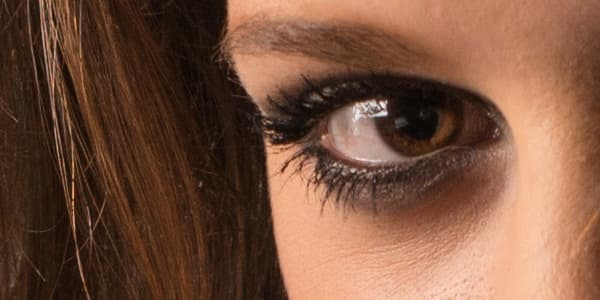
100% crop
The new 50mm f/1.4 is sharp. Really sharp. The studio shot above at f/5.6 shows superb detail, as can be seen in the 100% crop. Of course, we’d expect this at f/5.6, but what about larger apertures. Let’s take a look, starting with f/1.4:

100% crop
Even shooting wide open, there’s plenty of fine detail to be had, although the micro contrast is inevitably a little lower than at f/5.6. By far and away the biggest problem, in practice, is getting correct focus, especially when using the optical viewfinder of an SLR – I had the most success using the D800E’s ‘digital rangefinder’ function, in which a green dot in the viewfinder status display indicates correct focus. On the camera I was using, relying on the focusing screen tended to give fractional back focus.

100% crop
Stop down to f/2.8 and the lens gets visibly crisper, with every eyebrow and eyelash clearly delineated. The background remains attractively blurred, although obviously not as blurred as at f/1.4. Overall though this is a really impressive result from the new lens.
Zeiss Milvus 1.4/85
Like the 50mm f/1.4, the Milvus 85mm f/1.4 features a new optical formula, including an unusual concave front element. Again like its sibling, it’s stunningly sharp; if anything, I think it might be even better.
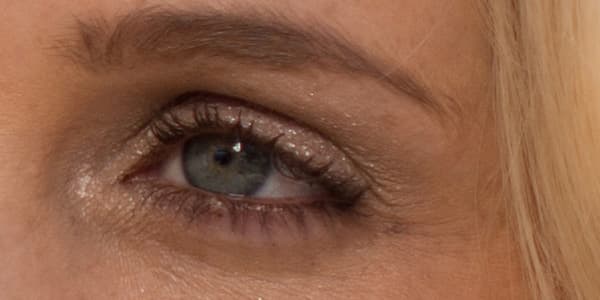
100% crop
Shot wide open at f/1.4, the detail here is extraordinary. The background has been blurred quite nicely too, despite being pretty messy. There’s a little vignetting visible, which in this case adds to the image, as it so often does.
Again, though, accurate focusing is critical, especially with lenses this sharp where the transition from in-focus to out-of-focus is very obvious indeed. It’s tremendously easy to end up a little bit out, especially when relying on the camera’s focus screen, which negates the point of having such a good lens. One a more positive note, out-of-focus regions of the image are usually rendered beautifully.
The lens’s impressive sharpness and lovely bokeh means that images also lens themselves well to black and white conversion:

100% crop
Again, from my initial shooting with this lens, it looks very promising indeed. Zeiss’s biggest problem, in fact, may be that it stops people from buying the Otus 85mm f/1.4.
Milvus 2/50 Macro
Like the 21mm f/2.8, this is a reworking of an existing ‘classic’ Zeiss lens. At f/2 it has an unusually fast maximum aperture for a macro, but the trade-off is its maximum half-life-size reproduction. But while purists might complain this means it’s not a ‘true’ macro lens, the reality is that this is much less meaningful with digital compared to film.
Like the other Milvus lenses, the 50mm f/2 combines impressive sharpness at maximum aperture with lovely bokeh:

100% crop
In the pair of pictures below, of the same subject shot at f/2 and f/11, we can see how the lens gives an impressive degree of creative control – one shows shallow depth if field and the water from the fountain ‘frozen’ with a fast shutter speed, the other has much deeper depth of field and blurred water.
This means that the Milvus 50mm f/2 Macro can double nicely as a fast normal prime, and as a close-focusing macro lens.
Milvus 2/100 Macro
This is another lens that’s based on an existing optical design – the legendary Macro-Planar T* 2/100. Even from shooting just a couple of studio portraits with it, it’s clear to me that this is also a very nice lens indeed.
Like the image below, this isn’t technically perfect; focus is a bit off, and the shutter speed is marginal, so there’s just a hint of camera shake. But if you take a step back and look at the image, rather than the pixels, it’s very nice indeed.
Initial thoughts
We fully intend to test several of the Milvus lenses fully in future – particularly the 50mm f/1.4 and the 85mm f/1.4 – but just from a few quick samples, it’s clear that they’re very nice indeed. As we’d expect from as respected a name as Zeiss, the optics are excellent, and the build and handling is superb. The only real question is how many photographers will be prepared to trade the convenience of autofocus for this kind of image quality, and pay the price premium that the ‘Made in Germany’ badge commands.

